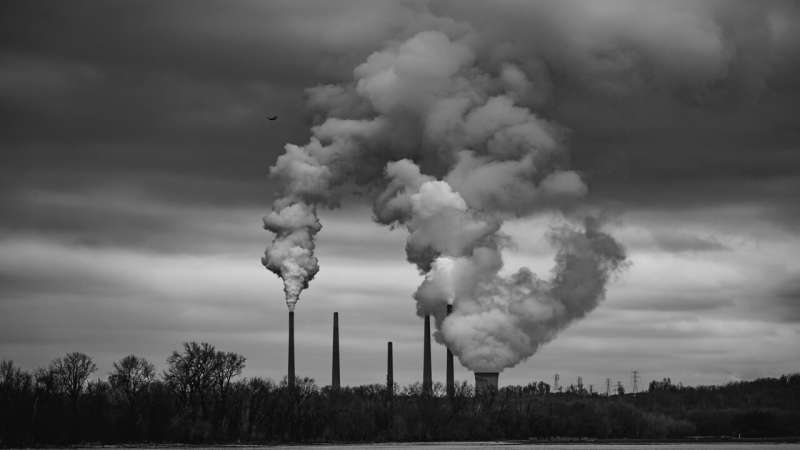Big corporations are getting away with catastrophic air pollution—putting Canadians at risk

Millions of kilograms of toxic pollutants, annually and environmental laws that aren't being diligently enforced. This is the troubling picture that emerged when we, a group of environmental researchers, investigated in Canada.
Federal and provincial governments share responsibility for regulating air pollution. However, environmental laws and regulations are only useful if they're properly enforced. Our research shows Canada needs to take greater action in enforcing the for air pollution. According to this principle, those who produce pollution should pay for cleaning up any environmental damage.
We in Canada of air pollution enforcement actions. We scoured all available sources, creating a database of more than 2,200 enforcement actions that took place between 2000 and 2020 from eight provinces as well as the federal government. This helped us identify patterns in the way air pollution laws were being enforced.
Broken rules
One of the disappointing patterns we saw is that the majority of enforcement actions in our dataset—63%—were against individuals for offenses such as illegal campfires. Meanwhile, only one-third of enforcement actions were brought against companies—including those that had into Canada's air, or caused catastrophic emissions offenses (such as the ).
Even in the uncommon cases where rules were enforced against large corporations, the penalties imposed were extremely lenient. These penalties amounted to barely a slap on the wrist for repeat industrial polluters.
For example, the mining corporation in Québec for breaking air pollution laws in 2013. This fine equated to only 0.00023% of the company's annual revenue. To put this into perspective, if a Canadian family earning the after taxes was given a 0.00023% fine, this would equate to $14.47.
It's not surprising, then, that this company would go on to less than one month later. They also violated these laws again in 2016 and 2019.
Even the relatively small fine of $150,000 is well above the median fine for industrial air polluters. According to our study, fines ranged from $2,500 to $10,000 for most types of offenses—including excess emissions or violating an environmental standard. This is less than some people would be fined for . These fines are less than 1% of the maximum penalties permitted by law for environmental offenses—which range .
Another concerning pattern our study revealed is that some large industrial polluters are repeat offenders. While indicate there should be increasingly strict enforcement applied in these cases, this doesn't appear to be the general practice. Instead, chronic law-breakers tended to receive multiple warning letters—not increasingly large fines or prosecutions.
For instance, over the last five years, were reportedly issued against INEOS—one of the world's largest chemical production companies. These orders were issued so the company would address its benzene emissions. This toxic chemical is .
Following federal and provincial orders to reduce benzene emissions in 2024, INEOS decided to . The company was never fined for its toxic pollution.
Enforcement actions don't seem to be taking into account the way are jeopardized by industrial air pollution. who live near large industrial facilities are particularly at risk of harm.
We found that on average, businesses were generally fined less for committing an actual pollution violation—such as illegally dumping large quantities of contaminants into the air—than they were for failing to notify an enforcement agency that they'd committed a violation.
Improving environmental enforcement
Canadian enforcement agencies are failing to properly hold high-risk offenders and repeat offenders to account.
But positive change is possible. Going forward, there are three key actions enforcement agencies should take:
- Increased penalties: Polluters should pay for their pollution. The consequences of breaking the law should be proportional to the risks to public health and the environment. Substantial mandatory minimum fines should replace the current practice of warning letters and grossly inadequate tickets or fines.
-
Transparency: The public should have access to environmental information through standardized data on air pollution violations. This information should include who committed the violation, the details and location of what occurred and what was done about it. Ideally, the federal government would co-ordinate and publish all environmental enforcement data from across provinces the same way it publishes a national inventory of industrial pollutant releases.
-
Focus on high-risk offenses: The focus of enforcement actions should be on high-risk offenders, such as super-polluters (businesses that produce disproportionate volumes of air pollution relative to their competitors), repeat offenders and inter-provincial offenders.
By properly enforcing environmental regulations, Canada can protect the public from the perils of poor air quality. This would also be a vital step towards realizing everyone's —a right that was recently recognized in an amendment to the .
Provided by The Conversation
This article is republished from under a Creative Commons license. Read the .![]()

















